Rome is custom built for tourists. The area surrounding the old city is filled with hundreds - hundreds of hotels. The city is railed and signed for tourists. And it is filled with tourists, even in the off season Ė March Ė when we went to avoid the tourists. We stayed at the Mediterraneo, two blocks from the strategically located Termini railway/metro station. The hotel was a delight, a refugee from the late fifties/early sixties, with big wide hallways, wood trim, useful room furniture, and a much better than average breakfast buffet. It was essentailly a studio apartment, complete with huge terrace. It was always a pleasure to come back to. The staff is extraordinarily helpful and accommodating. We canít say enough about the Mediterraneo. A terrific choice for us.
 |
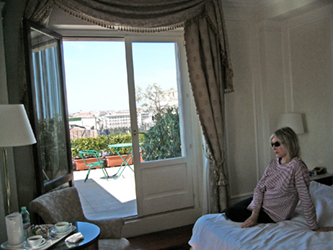 |
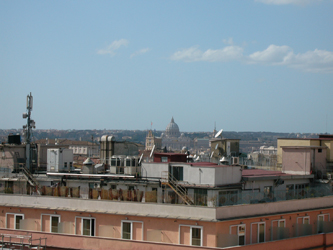 |
| Our room, west side | Our room, north terrace | Vatican view |
Rome is noisy. Like the financial district in New York, the base noise level is so high, the slightest addition means you have to raise your voice to have a conversation in the street. And there are lots of additions. Rush hour runs about 16 hours a day. Cars, trucks, buses combined with narrow streets and in general, no sidewalks off the main boulevards, means lots of intense noise.
The Smart has taken over. One out every ten cars is a Smart. We saw more Smarts in Rome than everywhere else in Europe combined. (That's ok - we love 'em.) A two seater that can be parked headed in to the sidewalk or wall, itís a great solution in a city with fifteen foot wide side streets that have cars parked their entire length. The other way to get around of course, is the motorcycle or scooter, and there are uncounted thousands. Theyíre pretty good about stopping for pedestrians, but you canít take it for granted Ė although the locals do. Roman drivers make New York cabs look like teenagers in driver ed.
As beautiful and as important as Rome is to western civilization, it is a crime that they let graffiti go uncontrolled. It is everywhere. It wouldnít be so bad if it was in any way creative or artistic. But it isnít. It is the lowest of low grade scrawlings, devoid of character, color or content. 2000 years of history should not be covered up in black spray paint.
On the other hand, marble is everywhere. From ancient Roman floors to modern walls and whole churches, marble in a rainbow of colors, patterns and quality decorate everything. A real change (and a real pleasure) from the cement and aluminum we're used to.
Food is a way of life. Outside of McDonald's, we saw no fast food joints. The city is unpolluted by Starbucks. But there are pizza joints. Pizza in every shape and form. Meals at restaurants are major events, taking a minimum of an hour if you rush them, two if youíre in a hurry, and three if youíre a local. Lunch only begins after 12:30, and dinner might be doable at 7, but 8 is safer.
A note to first timers Ė the absolute best place to change money is the post office. No hidden fees, a very decent exchange rate, but a bit of a bother as they are only open until 12:30!
It was easy to get in from the airport (FCO). A train costing just 11 euros does the trick in half an hour. It goes right to Termini, where the two metro lines join in a giant X through the city. And the metro only costs one euro, so itís a great solution after a day of walking. You can walk all day, seeing extraordinary sights and sites. We spent a day doing the Colosseum and the Forum, which is essentially downtown Rome from 2000 years ago. It is remarkably well preserved. But then, Rome used it as the town dump until the last century, so everything was just covered in fill. There are huge columns and walls everywhere, throughout the modern city. We in the west get excited about buildings that date from the late 1700s. In Rome, we saw buildings in the regular streets of the modern city that had dates like 15. The forum is just plain overwhelming. Remnants of absolutely huge temples, government buildings, and homes. Sports stadiums have not changed much in 2000 years. Same structure, same feeling, same atmosphere of gameday.
You walk the streets they did (often on the original stone streets or the original marble floors), climb the hills they did, visit the temples they did. The Roman Forum was a real city, and it was as dense and functional as any modern city. It is laid out in a very sensible grid, with major buildings guiding the eye as well as the foot. It is humbling.
 |
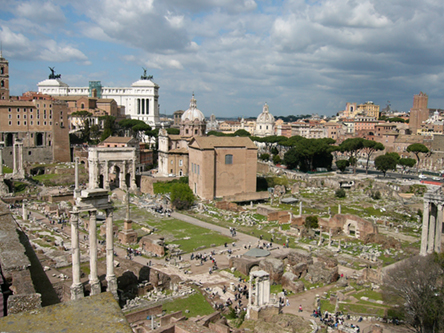 |
 |
| Marbled interior courtyard | Ancient Downtown - The Forum | Feels just like a modern stadium |
The Vatican is a must see, unfortunately. It was built to impress and overwhelm, and it is just plain overdone. The museum goes on forever, and thereís no doubt about the historical importance of it all. But it's just a massive show of monetary and artistic wealth. Itís one of hundreds, if not thousands of churches in Rome. Thereís a church about every couple of blocks. The Starbucks of Rome. Gets to be a bit much. Especially on the hour, when the bells do their thing.
More impressive to us than the Vatican was the Palazzo Colonna, an anonymous looking building from the outside, with the most fantastic ballroom/diningroom/reception room we have ever seen anywhere. Incredible varieties of marble, inlaid with other marble. A ceiling worthy of a Pope. Naturally, it was owned by a cardinal, who momentarily forgot his vow of poverty. A real underexposed gem, and itís only open Saturday mornings, 9-1. Despite what the website says, enter on the Via Pilota side (the rear entrance)
Walking Rome is great, but itís a daylight experience. Unfortunately, street signs, when they exist at all, are set in cement one floor up on the sides of buildings. So you canít see them at night. And as streets change their names every block or two, and donít follow any logical pattern or numbering system, finding your way is something to do during daylight hours only if you have to be somewhere. If youíre just walking, itís a pleasure discovering alleys and districts. Eventually, youíll hit a thoroughfare and can check your map. Even then, itís best to do Rome at night with a flashlight.
A related problem holds for driving. Almost no signs. Really hard to tell if youíre on the right street or highway. Our rental had 16 damage points on it, with only 37k km (20k miles). When I laughed at that, the agent pulled another damage report and told this ours was in great condition. This other one had two pages of damage listed. For Romans, driving is a game of millimeters, and they often lose. Insurance for foreigners is mandatory. The guidebooks actively discourage car renting. And to tell you the truth, I really didn't want to. Who needs the pressure on a vacation? But there are no trains to Amalfi, and we really wanted to see the coast....
We took a break from the frenzy of Rome and drove down to the Amalfi Coast. I got to drive the wildest road in the world, hugging the cliffsides, switching back and forth in hairpin turns, with convex mirrors warning you much better than the (few) signs that a very critical turn was coming up. The road is not quite wide enough for two buses, and everyone drives really fast, because it takes so long to get to where youíre going. Incredibly, people walk along (not that they have much choice) and risk their lives daily. Nancy said it was worse than any amusement park thrill ride she had ever been on. I took that as a compliment. As dangerous as the road was, Iíd take it any day over over just trying to get out of Rome on regular flat streets. Essentially no signs, bumper to bumper traffic, and an almost complete lack of highways.
The towns along the coast are built vertically, up the mountainsides. We stayed in the main town, Amalfi, at a terrific little hotel called Il Nido. We had a balcony overlooking the Mediterranean and town, and it was all quite magical. We were the only guests, this being March. It is hard to imagine the area in summer when 25 times as many tourists are there. It was quite crowded as it was. Amalfi is known for its lemons, which are the size of toy footballs. They make perfume, juices, and alcoholic beverages from them. The food is nothing special, but thatís the least of why you make the effort to get there. Itís just gorgeous and inventive.
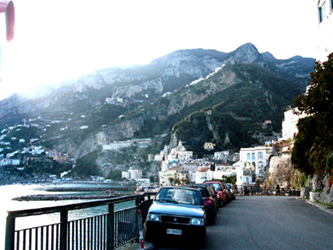 |
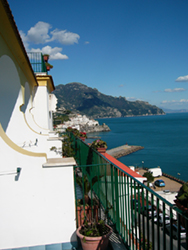 |
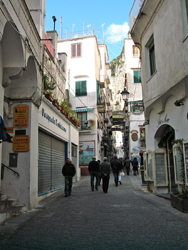 |
| Approaching Amalfi | View from Il Nido room terrace | Amalfi street with cliffs |
Another side trip took us north to Firenze (Florence). This time we had the (badly designed) major highway, so we did 150-160 (about 100mph) all the way. It was a little tricky at times, because trucks going half our speed would drift over to pass some other truck going even slower, and we discovered some major curves that are banked the wrong way, so you could easily shoot right off he road. Our experience was that the farther south you went, the crazier the drivers were. This was confirmed for us by a local who explained it as an indicator of wealth. The northerners were much more comfortable and laid back. The Romans scrambled to make a living, and the southerners weren't making it at all. And it is all reflected in their driving.
Firenze is the renaissance city, and it knows it. Everything has been kept intact, and is perfectly maintained. There is no recession here; it's tourism all day every day. We got to feeling that it a theme park. We heard more American than Italian. Nonetheless, it is of course, gorgeous. The Ponte Vecchio - the covered bridge filled with jewlery stores - is a beauty. The Uffizi Gallery is breathtakingly elegant and composed. (We bought our tickets online, which definitely saved us two hours in line this time, but Italy still hasn't figured out internet savings. There are surcharges as high as 50% for everything you purchase or reservre online. A little bizarre for 2009.) We even found the Perfumerie Santa Maria Novella, which is about 800 years old and has operated from the same streetfront building since 1612. Different rooms offer different products: perfumes, vinegars, herbs... All very fragrant. As everywhere, the major effort was put into the ceilings: intricate, detailed, beautiful. The wall frescoes were damaged up to about the five foot mark from the 1966 flood by the river Arno. Five feet wasn't bad; we saw high water marks on buildings at the eight foot level. Frightening.